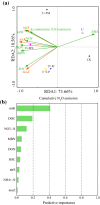Response of N2O emission and denitrification genes to different inorganic and organic amendments
- PMID: 35273224
- PMCID: PMC8913736
- DOI: 10.1038/s41598-022-07753-9
Response of N2O emission and denitrification genes to different inorganic and organic amendments
Abstract
Denitrification is a key biochemical process in nitrogen cycling and nitrous oxide (N2O) production. In this study, the impacts of different inorganic and organic amendments (OAs) on the abundance of denitrifying genes (nirS, nirK and nosZ) and the level of N2O emission were examined with incubation experiments. Six treatments included the indicated applications: (i) no fertilization (CK); (ii) urea application alone (U); (iii) wheat straw plus urea (U + WS); (iv) pig manure plus urea (U + PM); (v) compost product plus urea (U + CP); and (vi) improved compost product plus urea (U + IC). The results indicated that all fertilization treatments increased accumulative N2O emissions compared with the CK treatment. The U + WS, U + PM and U + CP treatments increased N2O emissions by 2.12-141.3%, and the U + IC treatment decreased N2O emissions by 23.24% relative to the U treatment. nirK was the dominant denitrification gene rather than nirS and nosZ found in soil. Additionally, the highest abundance of nirK gene was that with the U + PM treatment, and the lowest was that with the U + IC treatment. Additionally, changes in the nirK gene were highly correlated with levels of dissolved organic carbon (DOC), dissolved organic nitrogen (DON) and nitrate nitrogen (NO3-N). Automatic linear modeling revealed that N2O emission was closely related to the nirK gene, DOC and NO3-N. Overall, the use of urea and improved compost as co-amendments retarded N2O emission to a considerable degree compared with other OA additions.
© 2022. The Author(s).
Conflict of interest statement
The authors declare no competing interests.
Figures



Similar articles
-
Mitigation of soil N2O emissions by decomposed straw based on changes in dissolved organic matter and denitrifying bacteria.Sci Total Environ. 2023 Dec 20;905:167148. doi: 10.1016/j.scitotenv.2023.167148. Epub 2023 Sep 19. Sci Total Environ. 2023. PMID: 37730058
-
Effects of combined biochar and organic fertilizer on nitrous oxide fluxes and the related nitrifier and denitrifier communities in a saline-alkali soil.Sci Total Environ. 2019 Oct 10;686:199-211. doi: 10.1016/j.scitotenv.2019.05.394. Epub 2019 Jun 1. Sci Total Environ. 2019. PMID: 31176819
-
[Nitrous Oxide Emission and Denitrifying Bacterial Communities as Affected by Drip Irrigation with Saline Water in Cotton Fields].Huan Jing Ke Xue. 2020 May 8;41(5):2455-2467. doi: 10.13227/j.hjkx.201910137. Huan Jing Ke Xue. 2020. PMID: 32608865 Chinese.
-
Organic fertilization reduces nitrous oxide emission by altering nitrogen cycling microbial guilds favouring complete denitrification at soil aggregate scale.Sci Total Environ. 2024 Oct 10;946:174178. doi: 10.1016/j.scitotenv.2024.174178. Epub 2024 Jun 23. Sci Total Environ. 2024. PMID: 38917905
-
Soil nitrogen cycling gene abundances in response to organic amendments: A meta-analysis.Sci Total Environ. 2024 Apr 15;921:171048. doi: 10.1016/j.scitotenv.2024.171048. Epub 2024 Feb 20. Sci Total Environ. 2024. PMID: 38387590 Review.
Cited by
-
Impact of straw return on greenhouse gas emissions from maize fields in China: meta-analysis.Front Plant Sci. 2025 Feb 26;16:1493357. doi: 10.3389/fpls.2025.1493357. eCollection 2025. Front Plant Sci. 2025. PMID: 40078633 Free PMC article.
-
Comparative analyses on nitrogen removal microbes and functional genes within anaerobic-anoxic-oxic and deoxidation ditch sewage-treating processes in Wuhan and Xi'an cities, China.Front Microbiol. 2024 Oct 30;15:1498681. doi: 10.3389/fmicb.2024.1498681. eCollection 2024. Front Microbiol. 2024. PMID: 39539698 Free PMC article.
-
Irrigation System, Rather than Nitrogen Fertilizer Application, Affects the Quantities of Functional Genes Related to N2O Production in Potato Cropping.Microorganisms. 2025 Mar 25;13(4):741. doi: 10.3390/microorganisms13040741. Microorganisms. 2025. PMID: 40284578 Free PMC article.
-
Partial organic substitution for chemical fertilizer reduces N2O emissions but increases the risk of N loss through nitrification in Tibetan farmland.Sci Rep. 2025 Apr 25;15(1):14503. doi: 10.1038/s41598-025-97657-1. Sci Rep. 2025. PMID: 40281026 Free PMC article.
References
-
- IPCC . Climate change 2013: The Physical Science Basis. Contribution of Working Group I to the Fifth Assessment Report of the Intergovernmental Panel on Climate Change. Cambridge University Press; 2013.
-
- Pachauri RK, Allen MR, Barros VR, Broome J, Cramer W, Christ R, Church JA, Clarke L, Dahe Q, Dasgupta P. Climate change 2014: Synthesis report. Contribution of Working Groups I, II and III to the fifth assessment report of the Intergovernmental Panel on Climate Change. IPCC; 2014.
-
- Reay DS, Davidson EA, Smith KA, Smith P, Melillo JM, Dentener F, Crutzen PJ. Global agriculture and nitrous oxide emissions. Nat. Clim. Change. 2012;2:410–416.
-
- Jassal RS, Black TA, Roy R, Ethier G. Effect of nitrogen fertilization on soil CH4 and N2O fluxes, and soil and bole respiration. Geoderma. 2011;162:182–186.
-
- Hu HW, Chen D, He JZ. Microbial regulation of terrestrial nitrous oxide formation: Understanding the biological pathways for prediction of emission rates. FEMS Microbiol. Rev. 2015;39:729–749. - PubMed
Publication types
MeSH terms
Substances
LinkOut - more resources
Full Text Sources
Research Materials
Miscellaneous

